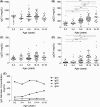Age-specific pediatric reference ranges for immunoglobulins and complement proteins on the Optilite™ automated turbidimetric analyzer
- PMID: 29603375
- PMCID: PMC6817213
- DOI: 10.1002/jcla.22420
Age-specific pediatric reference ranges for immunoglobulins and complement proteins on the Optilite™ automated turbidimetric analyzer
Abstract
Background: Measurement of immunoglobulins and complement proteins are frontline tests used in the assessment of immune system integrity, and reference values can vary with age. Their measurement provides an insight into the function of the innate and adaptive immune systems.
Methods: We generated pediatric reference ranges for IgG, IgA, IgM, IgD, the IgG and IgA subclasses, and C3 and C4 using the Optilite™ turbidimetric analyzer.
Results: The concentrations of IgG, IgA, and IgD showed an increase with age, as expected, while IgM remained stable between the age groups. For the IgG subclasses, no significant differences were observed in IgG1 or IgG3, while IgG2 and IgG4 concentrations increased steadily with age. The concentration of IgG2 plateaued at 15-18 years, while IgG4 plateaued at 10-14 years. The trend of concentrations across all groups was IgG1 > IgG2 > IgG3 > IgG4. For both IgA1 and IgA2, concentrations increased significantly with age, plateauing at 15-18 years. The median IgA1 concentration was greater than IgA2 across all groups. There was a good correlation between the total IgG or IgA concentration and summation of their subclasses (R2 = 0.89, P < .0001, slope y = 0.98x + 14.51 mg/dL and R2 = 0.91, P < .0001, slope y = 1.35x-3.28 mg/dL, respectively). The concentration of C3 and C4 remained stable across the groups, with no significant differences observed.
Conclusion: We have generated age-specific reference ranges in healthy children for C3, C4, IgG, IgA, IgM, IgD and the IgG and IgA subclasses using the Optilite™ turbidimetric analyzer. These ranges will help identify individuals with abnormal concentrations, thus will aid in the diagnosis of both primary and secondary immunological disorders.
Keywords: complement system proteins; immunodeficiency; immunoglobulins; pediatric reference values; turbidimetry.
© 2018 Wiley Periodicals, Inc.
Figures





Similar articles
-
Enumeration of human peripheral blood lymphocytes secreting immunoglobulins of major classes and subclasses in healthy children and adults.J Clin Immunol. 1991 Jul;11(4):213-8. doi: 10.1007/BF00917427. J Clin Immunol. 1991. PMID: 1918268
-
Antibodies prevalence against Haemophilus influenzae type b in Jeddah population, Saudi Arabia. II. Antibodies subclasses.Hum Antibodies. 2019;27(1):1-11. doi: 10.3233/HAB-180343. Hum Antibodies. 2019. PMID: 30103308
-
Gender dimorphism in IgA subclasses in T2-high asthma.Clin Exp Med. 2023 Jul;23(3):929-941. doi: 10.1007/s10238-022-00828-x. Epub 2022 Apr 25. Clin Exp Med. 2023. PMID: 35467314 Free PMC article.
-
Bacteroides gingivalis-specific serum IgG and IgA subclass antibodies in periodontal diseases.Clin Exp Immunol. 1990 Nov;82(2):318-25. doi: 10.1111/j.1365-2249.1990.tb05446.x. Clin Exp Immunol. 1990. PMID: 1978704 Free PMC article.
-
Structure and function of immunoglobulins.J Allergy Clin Immunol. 2010 Feb;125(2 Suppl 2):S41-52. doi: 10.1016/j.jaci.2009.09.046. J Allergy Clin Immunol. 2010. PMID: 20176268 Free PMC article. Review.
Cited by
-
IgG antibody response to pneumococcal-conjugated vaccine (Prevenar®13) in children with immunodeficiency disorders.Med Microbiol Immunol. 2023 Feb;212(1):93-102. doi: 10.1007/s00430-022-00759-0. Epub 2023 Jan 3. Med Microbiol Immunol. 2023. PMID: 36595027
-
Circulating prolactin level in Juvenile Systemic Lupus Erythematosus and its correlation with disease activity: a case control study.Pediatr Rheumatol Online J. 2023 Oct 20;21(1):128. doi: 10.1186/s12969-023-00915-7. Pediatr Rheumatol Online J. 2023. PMID: 37864188 Free PMC article.
-
Commercialized kits to assess T-cell responses against SARS-CoV-2 S peptides. A pilot study in health care workers.Med Clin (Engl Ed). 2022 Aug 12;159(3):116-123. doi: 10.1016/j.medcle.2021.09.028. Epub 2022 Aug 19. Med Clin (Engl Ed). 2022. PMID: 35999826 Free PMC article.
-
Polymorphisms in Fc Gamma Receptors and Susceptibility to Malaria in an Endemic Population.Front Immunol. 2020 Nov 12;11:561142. doi: 10.3389/fimmu.2020.561142. eCollection 2020. Front Immunol. 2020. PMID: 33281811 Free PMC article. Review.
-
ERS International Congress 2022: highlights from the Thoracic Surgery and Lung Transplantation Assembly.ERJ Open Res. 2023 Apr 17;9(2):00671-2022. doi: 10.1183/23120541.00671-2022. eCollection 2023 Mar. ERJ Open Res. 2023. PMID: 37077552 Free PMC article. Review.
References
-
- Perlmutter DH, Colten HR. Molecular immunobiology of complement biosynthesis: a model of single‐cell control of effector‐inhibitor balance. Annu Rev Immunol. 1986;4:231‐251. - PubMed
-
- Alberts B. Molecular Biology of the Cell. 4th edn. New York, NY: Garland Science; 2002:xxxiv, 1548
-
- Song WC, Sarrias MR, Lambris JD. Complement and innate immunity. Immunopharmacology. 2000;49:187‐198. - PubMed
Grants and funding
LinkOut - more resources
Full Text Sources
Other Literature Sources
Miscellaneous

